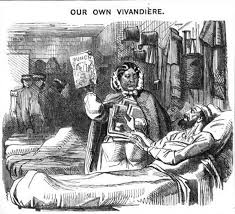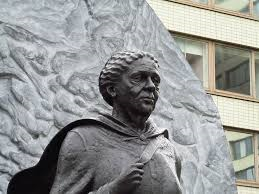The life, and public memory, of Mary Seacole (1805-1881)
Mary Seacole [née Grant] (1805–1881) is best known as the nurse who, after trying unsuccessfully to join Florence Nightingale’s group of nurses, borrowed money to fund herself to travel to the Crimean War. Seacole arrived in the Crimea in February 1855 and remained until July 1856. During this time she opened the ‘British Hotel’ near the front and used this base to travel back and forth to the battle-front dispensing medical treatment to the injured and dying.
Seacole is particularly interesting because she was financially independent. Although she faced bankruptcy after the war, being self-funded gave her independence from the formal nursing service and this ensured her a freedom of movement denied other women at this time. She was a well-known figure in the mid-nineteenth century amongst Crimean war correspondents, the historical archives of British newspapers at the time are therefore a useful source for her time in Crimea. A search of her name in the Times Digital Archive, for example, reveals a spike of coverage in the year she was in Crimea. When she was declared bankrupt after the war, appeals to reimburse her Crimea expenses were supported by The Times and Punch.[i]

Seacole also wrote an autobiography, published in 1857: Wonderful Adventures of Mrs Seacole in Many Lands. This autobiography, written to raise much-needed funds after her bankruptcy, was the first autobiography to be wholly authored by a black woman in England and covers her life up to and including her time in Crimea – offering valuable insights into her experience as a Black woman in England and abroad. [ii]
Despite attempts to keep her memory alive – for example, Seacole’s grave at Kensal Green cemetery was reconsecrated in 1973 and honours her ‘care for the sick and wounded in the West Indies, Panama and on the battlefields of the Crimea’” – Seacole seems to have slipped from public memory until the millennium[iii] when her re-discovery as ‘The forgotten angel of the Crimea’ began.[iv] In February 2004 Seacole was voted the ‘greatest Black Briton’ in an internet survey. The following year Penguin Classics reissued Seacole’s autobiography and the National Portrait Gallery in London unveiled a newly discovered portrait. [v] In 2016, following a 12 year campaign, a statue was unveiled in London opposite the Houses of Parliament in the grounds of St Thomas’ Hospital.[vi]

Library resources are a useful place to start researching the life, and memory, of Mary Seacole. Most of these are online and accessible via the library catalogue: a good place to start is to search for ‘Mary Seacole’ in Article Search or JSTOR, followed by a trawl through historic newspaper archives such as The Times Digital Archive – also available via the Library catalogue.
We also have two print books on display as part of our Black History Month exhibition:
- Wonderful adventures of Mrs Seacole in many lands / edited by Ziggi Alexander & Audrey Dewjee
- A short history of Mary Seacole : a resource for nurses and students / Elizabeth N. Anionwu
[i] “Seacole Fund – The disinterested services of.” Times, 11 Mar. 1867, p. 5. The Times Digital Archive, http://tinyurl.gale.com/tinyurl/ByE9g3. Accessed 21 Oct. 2019.
[ii] See images and a transcript of this text at: https://www.bl.uk/learning/timeline/item126795.html; for an analysis of the autobiography see for example: Pinto, S. (2019). “The Right Woman in the Right Place”: Mary Seacole and Corrective Histories of Empire. ariel: A Review of International English Literature 50(2), 1-31. doi:10.1353/ari.2019.0012 and Craig, Christine. “Wonderful adventures of Mrs Seacole in many lands: Autobiography as Literary Genre and a Window to Character.” Caribbean Quarterly 30, no. 2 (1984): 33-47. http://www.jstor.org/stable/40653534.
[iii] Palmer, A. (2006, May 25). Seacole [née Grant], Mary Jane (1805–1881), nurse. Oxford Dictionary of National Biography. Retrieved 14 Oct. 2019, from https://www.oxforddnb.com/view/10.1093/ref:odnb/9780198614128.001.0001/odnb-9780198614128-e-41194.
[iv] Carpenter, Sue. “The forgotten angel of the Crimea.” Times, 4 Sept. 2000, p.52. The Times Digital Archive, http://tinyurl.gale.com/tinyurl/ByDxB7. Accessed 21 Oct. 2019.
[v] The survey was organised in response to the absence of black people in the top 100 of the BBC’s Greatest Briton poll and this publicity ensured further coverage in the British press. ‘Nurse is greatest Black Briton’ The Guardian 10 February 2004: https://www.theguardian.com/uk/2004/feb/10/britishidentity.artsandhumanities (Accessed 21/10/2019); “In Brief – Mary Seacole: SURVEYS EDITION].” Financial Times, Feb 05, 2005 ; Watson, Kathy. “The Other Nightingale.” New Statesman, Jan 17, 2005, 48-49, https://queens.ezp1.qub.ac.uk/login?url=https://search.proquest.com/docview/224331441?accountid=1337
[vi] ‘Mary Seacole statue unveiled in London’ BBC News. 30 June 2016. https://www.bbc.co.uk/news/uk-england-london-36663206

